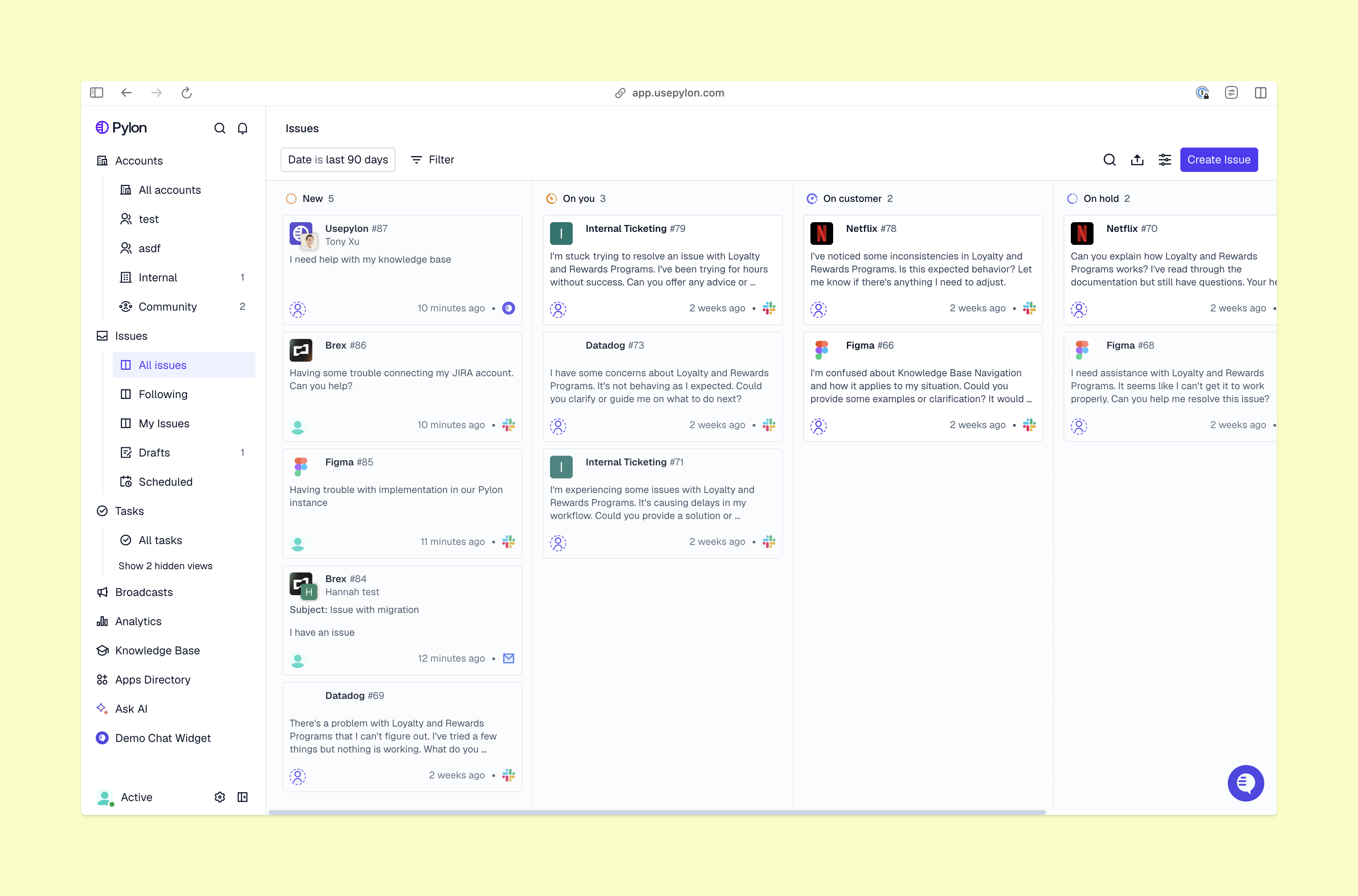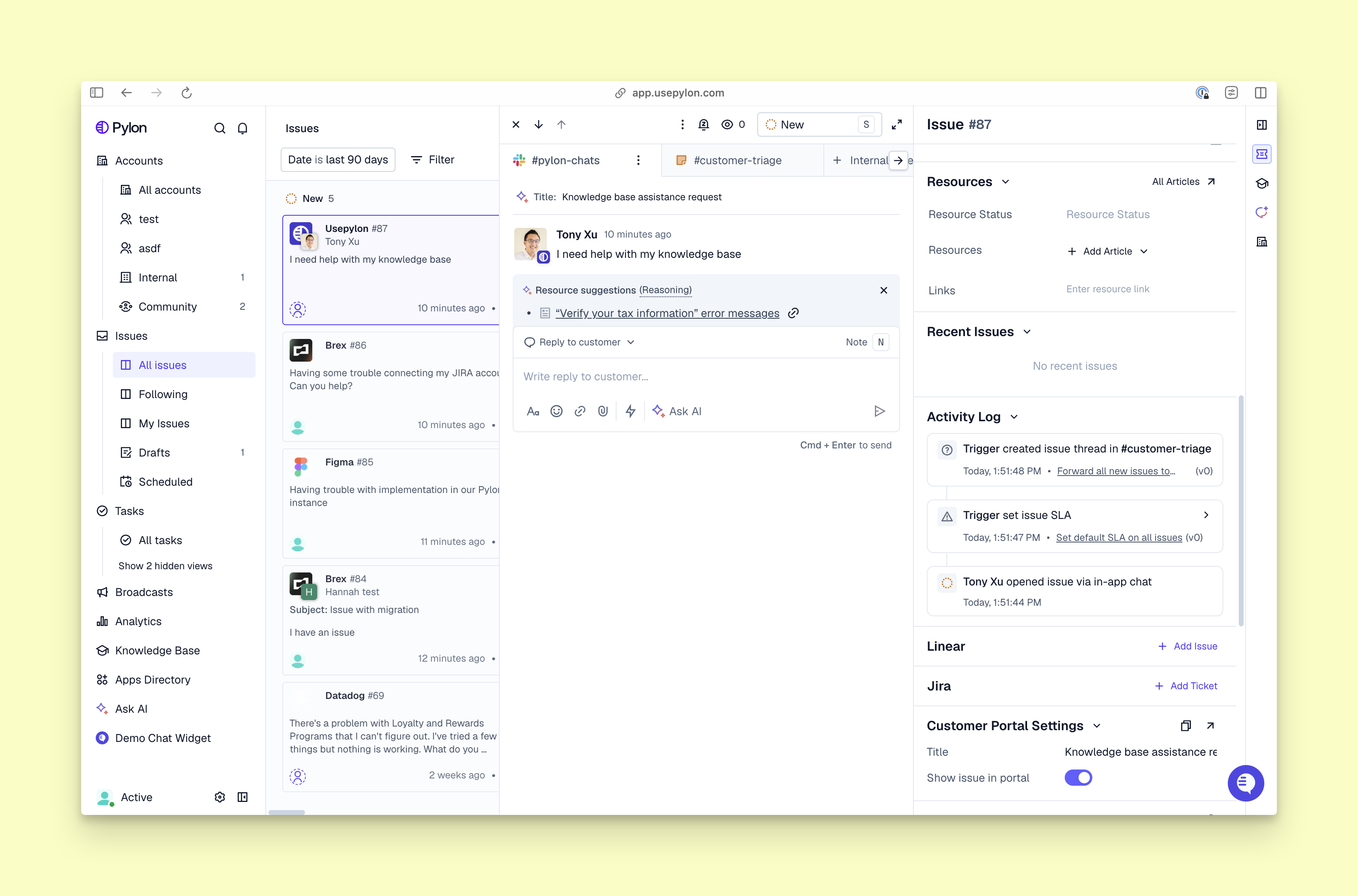The Complete Guide to Slack Integrations for Customer Support in 2025
The right Slack integration transforms scattered customer conversations into streamlined support experiences. This comprehensive guide compares the top 6 platforms—from modern omnichannel tools like Pylon to traditional tools like Zendesk—to help you choose the best fit for your team size, budget, and support strategy.
Updated October 29, 2025 | 18 min read
TL;DR
- Choosing the right Slack integration for customer support depends on your team size, complexity, and workflow needs.
- Top options include Pylon (best for B2B teams who need native omnichannel support), Zendesk (for traditional enterprises), Intercom (for conversational support), and HubSpot Service Hub (for teams already using HubSpot CRM).
- The key is finding a solution that centralizes customer conversations, automates ticket management, and integrates seamlessly with your existing tech stack.
Why Slack Customer Support Matters in 2025
B2B customers increasingly expect support where they already work—and Slack has over 2,400 apps available on its platform. For modern support teams, meeting customers in Slack isn't just convenient, it's essential for retention and satisfaction.
But Slack alone isn't enough. Without the right integrations, customer conversations become scattered across channels, tickets get lost, and your resolution times suffer. The solution? Best-in-class Slack integrations that transform your messaging workspace into a complete customer support engine.
This guide covers the top support platforms with Slack integration, helping you choose the best Slack add-ons for support teams based on your specific needs.
What to Look for in a Slack Customer Support Integration
Before evaluating specific tools, you should understand what separates great Slack integrations from basic ones:
Essential Features:
- Native Slack functionality – Complete ticket management without switching platforms
- Automated request detection – AI-powered identification of customer issues in real-time
- Bi-directional sync – Seamless two-way communication between Slack and your support platform
- Omnichannel support – Unified inbox for Slack, email, chat, and other channels
- Team collaboration – Easy escalation, assignment, and context-sharing
- Analytics and reporting – Track SLAs, response times, and customer satisfaction
- Security and compliance – Enterprise-grade data protection for customer interactions
According to research on customer support software, teams using integrated platforms see up to 40% faster resolution times compared to those managing multiple separate systems.
Top 10 Slack Integrations for Customer Support
1. Pylon – Best for B2B Omnichannel Support

Ideal for: B2B companies that prioritize a seamless omnichannel experience
Pylon is purpose-built for B2B customer support teams that need to manage Slack alongside email, in-app chat, and community channels. Unlike basic integrations that only push notifications, Pylon enables a true omnichannel support experience where all customer conversations are unified in one platform.
Key features:
- Full Slack integration with native ticket creation and management
- Omnichannel inbox consolidating Slack, email, chat, and community support
- Bi-directional sync so you can reply to the same customer thread from Pylon or Slack
- AI-powered issue detection and routing
- Advanced analytics and SLA tracking
- Seamless CRM integrations (Salesforce, HubSpot, Attio)
- Custom workflows and automations
- Built-in AI knowledge base and customer portal
Why it stands out:
Pylon doesn't just integrate natively with Slack, it unifies your customer support across every single channel. The platform's AI Agents and AI Assistants automatically categorize issues, suggest relevant knowledge base articles, and route tickets to the right team members.
Teams using Pylon report significantly faster first response times and less context-switching between tools. The platform's Slack-as-a-ticketing-system approach makes Slack support natural for teams and their customers.
Pricing: Contact for custom pricing based on team size and features
Learn more: Pylon Docs | Knowledge Base
2. Zendesk – Best for Traditional Enterprise Operations
Ideal for: Traditional organizations with multi-department needs
Zendesk is an established customer service software platform with comprehensive ticketing across email, phone, chat, and social channels.
Key features:
- Slack notifications for ticket updates
- Automated ticket assignment based on predefined rules
- Side conversations within Slack threads
- Answer Bot for knowledge base article suggestions
- Multiple Zendesk account connections to Slack workspaces
Limitations:
Zendesk's Slack app offers basic functionality but doesn’t have true bi-directional, conversational ticketing. Teams have to supplement with additional tools or consider Zendesk alternatives that offer native Slack integration.
Pricing: From $19/seat/month to $169/seat/month
3. Intercom – Best for Chat Support
Ideal for: SaaS companies that prioritize real-time chat
Intercom specializes in chat support, blending AI automation with human customer service across chat, email, and social media.
Key features:
- Live chat management in Slack
- AI-powered chatbots for automated responses
- Real-time customer messaging
- Ticket sync between Intercom and Slack
- Proactive messaging capabilities
Limitations:
Each customer request creates a separate Slack channel, which becomes difficult to manage at scale. Conversations don't always link smoothly to customer history.
Pricing: From $29/seat/month to $132/seat/month, plus usage-based charges
4. HubSpot Service Hub – Best for HubSpot CRM Users
Ideal for: Marketing-led SMBs already using HubSpot's ecosystem
HubSpot Service Hub integrates customer service tools with its popular CRM, providing ticketing, knowledge base, and feedback management.
Key features:
- Ticketing and knowledge base access from Slack
- Real-time customer feedback collection
- Workflow-triggered Slack notifications
- Integrated team collaboration
- Native HubSpot CRM data access
Limitations:
HubSpot Service Hub’s Slack integration is limited compared to their web interface. The jump from $9/month to $90/month pricing can also be steep for growing teams.
Pricing: From $9/seat/month to $150/seat/month per seat
5. Freshdesk – Best for Cost-Conscious Teams
Ideal for: Lean support teams who need affordable multi-channel ticketing
Freshdesk provides straightforward support management across email, chat, phone, and social channels.
Key features:
- Cross-channel support management from Slack
- Slash commands for quick ticket creation (/create_ticket)
- Collaborative ticket discussions synced as private notes
- Real-time agent notifications
- Quick status and priority updates
Limitations:
The Slack integration can be noisy and less intuitive than competitors in this list. Its basic functionality means you might need supplemental tools if you want to configure advanced workflows.
Pricing: From $15/seat/month to $79/seat/month
6. Salesforce Service Cloud – Best for CRM-First Organizations
Ideal for: Traditional enterprises deeply embedded in Salesforce CRM
Salesforce Service Cloud provides comprehensive case management with deep CRM integration for teams already using Salesforce.
Key features:
- Complete customer profiles and case histories in Slack
- Automated case assignment and escalation
- Cross-department collaboration with full context
- Case swarming via dedicated Slack channels
- Unified Customer 360 view
Limitations:
Setup complexity can be challenging for smaller teams. The Slack integration is often criticized for being clunky and requiring significant configuration.
Pricing: From $25/user/month to $500/user/month
Comparison Table: Top Slack Support Integrations
How to Choose the Right Slack Integration for Your Team
By Team Size:
Small teams (1-10 members):
- Consider: Pylon, Freshdesk
- Priority: Easy setup, affordable and/or flexible pricing, essential features
Mid-sized teams (10-50 members):
- Consider: Pylon, Zendesk, Intercom, HubSpot
- Priority: AI capabilities, automation, analytics, scalability
Large teams (50+ members):
- Consider: Pylon, Zendesk, Salesforce Service Cloud, Kustomer
- Priority: Advanced workflows, integrations, enterprise security
By Use Case:
B2B SaaS Companies:Prioritize platforms that offer omnichannel B2B support like Pylon, which unifies Slack with email and in-app chat for a seamless customer experience.
Technical Product Companies:Consider tools with strong developer workflows, like connections to Jira or Linear, or platforms with robust knowledge base software capabilities.
High-Touch Customer Success:Look for solutions emphasizing relationship management and proactive support, like Pylon’s Account Intelligence.
Omnichannel Needs:If you're helping customers across Discord, Microsoft Teams, and Slack, choose a platform designed for true omnichannel support.
Best Practices for Slack Support Integration
1. Organize Channels by Priority and Type
Avoid the single-channel trap. Structure your Slack workspace strategically:
- #vip-customers – High-value accounts requiring immediate attention
- #product-issues – Technical problems needing engineering escalation
- #onboarding-help – New customer questions and setup assistance
- #feature-requests – Product feedback and enhancement ideas
Tools like Pylon can automatically route conversations to the appropriate channels based on keywords, urgency, and customer attributes.
2. Customize Notifications to Reduce Noise
Alert fatigue is real. Configure notifications strategically:
- Filter by urgency (escalated tickets only)
- Set assignee-specific alerts (just your tickets)
- Create topic-based routing (technical issues to engineering channel)
3. Leverage Automation for Common Workflows
Automate repetitive tasks to free up your team’s time:
- Auto-assign tickets based on expertise and availability
- Send proactive SLA breach warnings
- Generate CSAT surveys after ticket resolution
- Create knowledge base article suggestions for common questions
According to research on Slack customer support tools, teams using automation resolve 60% more tickets without increasing headcount.
4. Use AI to Enhance Support Quality
Modern platforms offer AI capabilities that go beyond basic automation:
- Sentiment analysis – Identify frustrated customers before issues escalate
- Intent detection – Automatically categorize and route requests
- Smart suggestions – Recommend relevant knowledge base articles
- Predictive analytics – Anticipate support volume and staffing needs
5. Maintain Clear Escalation Paths
Define when and how to escalate issues:
- Set up dedicated escalation channels with clear SLAs
- Use tags and priority flags for urgent matters
- Create runbooks for common escalation scenarios
- Enable cross-team collaboration without losing context
6. Track Metrics That Matter
Monitor KPIs that drive continuous improvement:
- First Response Time (FRT) – How quickly do you acknowledge requests?
- Time to Resolution (TTR) – How long until issues are fully resolved?
- Customer Satisfaction (CSAT) – Are customers happy with support quality?
- Resolution Rate – What percentage of tickets are resolved on first contact?
- SLA Compliance – Are you meeting service level commitments?
Learn more about tracking key metrics in our guide to 13 customer support KPIs B2B businesses need to track.
Integration Spotlight: Pylon for Slack Support

While this guide covers multiple options, we’re spotlight Pylon for teams who are serious about modernizing B2B customer support.
What Makes Pylon Different?
1. True Omnichannel ArchitectureUnlike other solutions that just bolt onto Slack, Pylon was built from the ground up as an omnichannel platform. Customer conversations from Slack, email, in-app chat, and community forums all flow into a unified inbox where your team has complete conversational context.
2. Native Slack ExperiencePylon's Slack integration is native, which means support teams and customers can seamlessly manage ticket creation, status updates, and resolution in-thread. Conversations in Slack also sync bi-directionally to Pylon, so you can do less context-switching.
3. AI-Powered IntelligencePylon's AI doesn't just automate responses—it understands context, detects sentiment, and proactively surfaces relevant insights about your accounts. The platform learns from your team's support interactions to give you the most complete customer context.
4. Designed for B2B ComplexityB2B support differs significantly from B2C. Pylon handles multi-stakeholder conversations, account hierarchies, and complex SLAs that typical consumer-focused tools struggle with.
Real Results from Pylon Customers
Companies like AssemblyAI, Hightouch, and Coalesce have transformed their support operations with Pylon:
- Faster first response times compared to previous solutions
- Less context-switching between tools
- Improvement in CSAT scores within 90 days
- Decrease in missed customer requests through automated detection
Read their case studies to see how leading B2B companies leverage Pylon to scale support.
Common Slack Support Integration Challenges and Solutions
Challenge 1: Notification Overload
Problem: Too many Slack notifications create noise and missed important messages.
Solution: Use intelligent filtering and custom notification rules. Configure your integration to alert only on high-priority items like SLA breaches, VIP customer requests, or @mentions.
Challenge 2: Lost Customer Context
Problem: Conversations happen across multiple Slack channels and threads, losing valuable history.
Solution: Choose platforms like Pylon that automatically unify customer interactions across channels, maintaining complete conversation history with relevant account data.
Challenge 3: Manual Ticket Creation
Problem: Teams spend time manually converting Slack messages into tickets in separate systems.
Solution: Implement AI-powered auto-detection that identifies customer requests and creates tickets automatically. Platforms like Pylon can detect issues even when customers don't explicitly file a ticket.
Challenge 4: Siloed Teams
Problem: Support, engineering, and success teams work in separate Slack channels without visibility into customer issues.
Solution: Use integrations that enable cross-functional collaboration while maintaining security and privacy. Create shared channels for escalations with proper permissions and context.
Challenge 5: Measuring Performance
Problem: Slack's native analytics don't provide support-specific metrics like SLA compliance or resolution rates.
Solution: Integrate with platforms like Pylon that have robust reporting dashboards. Track metrics in real-time and generate custom reports for stakeholders.
The Future of Slack Customer Support
The landscape of customer support continues evolving rapidly. Here are trends shaping Slack integrations in 2025 and beyond:
1. AI-First Support
Artificial intelligence is moving from nice-to-have to essential. Next-generation Slack integrations use AI for:
- Predictive issue detection before customers report problems
- Automated response generation that’s still high quality
- Intelligent routing based on historical performance and expertise
- Sentiment-driven escalations for at-risk accounts
2. Deeper Platform Integration
The line between "messaging app" and "support platform" continues blurring. Modern solutions treat Slack as a first-class channel alongside email and chat, not an afterthought integration.
3. No-Code Customization
Teams demand flexibility without engineering resources. Leading platforms now offer visual workflow builders, custom field creation, and automation setup accessible to non-technical users.
4. Proactive Support
Reactive ticket management is giving way to proactive engagement. Platforms now monitor customer behavior, product usage, and health scores to trigger outreach before problems escalate.
5. Unified Customer Data
Support teams need complete customer context. The best integrations pull data from CRMs, billing systems, and data warehouses into a single view.
Learn more about these trends in our article on how B2B support teams are moving faster with AI.
Frequently Asked Questions (FAQ)
1. Can Slack fully replace a traditional help desk?
Yes and no. With the right integration, Slack can serve as your primary support interface for customers who prefer it. But you'll still need supporting infrastructure for email, knowledge base, analytics, and customer data management. Platforms like Pylon combine Slack-native support with traditional helpdesk functionality in one system.
2. How do Slack integrations handle customer privacy and security?
Enterprise-grade Slack integrations maintain SOC 2 compliance, encrypt data in transit and at rest, and offer granular permission controls. When you’re evaluating options, ask about GDPR compliance, data residency options, and audit logging capabilities. Check each vendor's security page for specific certifications.
3. What's the difference between Slack Connect support and internal Slack support?
Slack Connect enables direct channels between your organization and external customers, while internal support happens within your workspace. Good integrations handle both scenarios, allowing you to manage customer-facing Slack Connect channels alongside internal requests from employees or other teams.
4. Do I need a Slack integration if I already have a ticketing system?
Probably yes. Most Slack integrations don't replace your existing ticketing system—they extend it. Bi-directional sync means tickets created in Slack automatically sync to platforms like Pylon, and messages from Pylon sync to the Slack thread with customers. This creates a unified experience without forcing tool changes.
5. How long does it take to implement a Slack support integration?
Implementation varies by platform complexity. Simple integrations take 15-30 minutes. More comprehensive platforms typically require 1-2 weeks for full setup, customization, and team training—though basic functionality can be operational within hours.
6. Can multiple team members use Slack integrations simultaneously?
Yes, all enterprise Slack integrations support team members working at the same time. Features like round-robin ticket assignment, workload balancing, and collision detection prevent multiple team members from working the same issue. Most platforms charge per seat or offer unlimited seats above certain tiers.
7. What happens to Slack message history when using support integrations?
Quality integrations preserve full conversation history, storing messages within both Slack and the support platform. This ensures customer context remains available even if Slack messages are deleted or archived. Look for platforms that offer long-term retention and searchable archives.
8. How do Slack integrations handle different time zones and 24/7 support?
Most platforms offer flexible scheduling, SLA rules that account for business hours across time zones, and round-robin routing to global teams. Features like after-hours automation, follow-the-sun routing, and timezone-aware escalations ensure continuous coverage without manual intervention.
9. Can Slack integrations support multiple languages?
Advanced platforms offer multi-language support, including AI translation, language detection, and automatic routing to team members with language skills. However, capabilities vary significantly—make sure vendors can meet your language or translation requirements with before your commit.
10. What's the typical ROI timeline for implementing Slack support integrations?
Most teams see positive ROI within 30-90 days through faster response times, reduced tool switching, and improved customer satisfaction. Quantifiable benefits include decreased resolution time (25-40%), reduced agent overhead (15-30%), and improved CSAT scores (10-25 points). Calculate your specific ROI by estimating time savings per ticket multiplied by daily volume.
Getting Started with Slack Support Integrations
Ready to transform your customer support experience? Here's your step-by-step implementation plan:
Week 1: Assessment and Planning
- Audit current support channels and tools
- Document pain points and desired improvements
- Define success metrics (response times, CSAT, etc.)
- Identify stakeholders and get buy-in
Week 2: Tool Evaluation
- Request demos from 3-5 platforms matching your criteria
- Test integrations with trial accounts
- Evaluate user experience for both agents and customers
- Calculate total cost of ownership including hidden fees
Week 3: Implementation
- Set up your chosen platform with core features
- Configure channels, routing rules, and automations
- Import historical data and customer information
- Integrate with existing tech stack (CRM, analytics, etc.)
Week 4: Training and Optimization
- Train support team on new workflows
- Create documentation and playbooks
- Monitor early metrics and gather feedback
- Iterate on configuration based on real usage
Ongoing: Continuous Improvement
- Review performance metrics monthly
- Expand automation and AI capabilities
- Add new channels as customer preferences evolve
- Stay updated on platform enhancements
Conclusion: Choosing Your Slack Support Integration
The right Slack integration transforms chaotic customer conversations into structured, measurable support experiences. Your choice depends on several factors:
- Team size and growth trajectory
- Existing tech stack and CRM
- Primary support channels (Slack, email, in-app chat, etc.)
- Budget and pricing model preferences
- Industry-specific requirements
For B2B teams prioritizing omnichannel excellence, Pylon offers unmatched capability, unifying Slack, email, in-app chat, and more with AI-powered customer intelligence. The platform scales from startups to enterprises without compromising speed or flexibility.
Regardless of which platform you choose, the most important decision is moving from reactive, scattered support to proactive, unified customer experiences. The companies winning in B2B don't just answer questions—they anticipate needs, provide context-rich assistance, and build relationships that drive retention.
Additional Resources
- Complete Guide to Using Slack for Customer Support
- Slack vs Traditional Help Desks: What's Right for B2B?
- Setting Up Customer Support from Scratch
- B2B Customer Service Best Practices
- How to Scale B2B Customer Support Effectively
Ready to elevate your Slack customer support? Pylon is the modern B2B support platform that offers true omnichannel support across Slack, Teams, email, chat, ticket forms, and more. Our AI Agents & Assistants automate busywork and reduce response times. Plus, with Account Intelligence that unifies scattered customer signals to calculate health scores and identify churn risk, we're built for customer success at scale.









